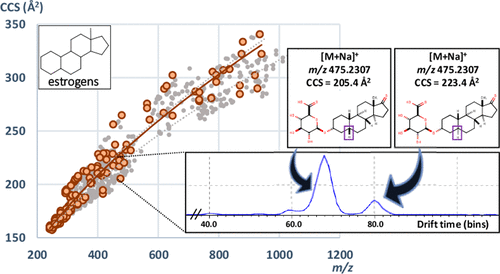当前位置:
X-MOL 学术
›
Anal. Chem.
›
论文详情
Our official English website, www.x-mol.net, welcomes your
feedback! (Note: you will need to create a separate account there.)
Collision Cross Section (CCS) Database: An Additional Measure to Characterize Steroids
Analytical Chemistry ( IF 6.7 ) Pub Date : 2018-03-12 00:00:00 , DOI: 10.1021/acs.analchem.7b05117 Maykel Hernández-Mesa 1 , Bruno Le Bizec 1 , Fabrice Monteau 1 , Ana M. García-Campaña 2 , Gaud Dervilly-Pinel 1
Analytical Chemistry ( IF 6.7 ) Pub Date : 2018-03-12 00:00:00 , DOI: 10.1021/acs.analchem.7b05117 Maykel Hernández-Mesa 1 , Bruno Le Bizec 1 , Fabrice Monteau 1 , Ana M. García-Campaña 2 , Gaud Dervilly-Pinel 1
Affiliation

|
Ion mobility spectrometry enhances the performance characteristics of liquid chromatography–mass spectrometry workflows intended to steroid profiling by providing a new separation dimension and a novel characterization parameter, the so-called collision cross section (CCS). This work proposes the first CCS database for 300 steroids (i.e., endogenous, including phase I and phase II metabolites, and exogenous synthetic compounds), which involves 1080 ions and covers the CCS of 127 androgens, 84 estrogens, 50 corticosteroids, and 39 progestagens. This large database provides information related to all the ionized species identified for each steroid in positive electrospray ionization mode as well as for estrogens in negative ionization mode. CCS values have been measured using nitrogen as drift gas in the ion mobility cell. Generally, direct correlation exists between mass-to-charge ratio (m/z) and CCS because both are related parameters. However, several steroids mainly steroid glucuronides and steroid esters have been characterized as more compact or elongated molecules than expected. In such cases, CCS results in additional relevant information to retention time and mass spectral data for the identification of steroids. Moreover, several isomeric steroid pairs (e.g., 5β-androstane-3,17-dione and 5α-androstane-3,17-dione) have been separated based on their CCS differences. These results indicate that adding the CCS to databases in analytical workflows increases selectivity, thus improving the confidence in steroids analysis. Consequences in terms of identification and quantification are discussed. Quality criteria and a construction of an interlaboratory reproducibility approach are also reported for the obtained CCS values. The CCS database described here is made publicly available.
中文翻译:

碰撞截面(CCS)数据库:表征类固醇的另一种措施
离子迁移谱仪通过提供新的分离尺寸和新颖的表征参数(所谓的碰撞截面(CCS)),增强了用于类固醇分析的液相色谱-质谱仪工作流程的性能特征。这项工作提出了第一个CCS数据库,其中包含300种类固醇(即内源性的,包括I和II期代谢物以及外源性合成化合物),涉及1080个离子,涵盖了127个雄激素,84个雌激素,50个皮质类固醇和39个孕激素的CCS。 。这个庞大的数据库提供了与在正电喷雾电离模式下为每个类固醇以及在负电离模式下的雌激素相关的所有离子化物种的信息。CCS值已使用离子迁移池中的氮气作为漂移气体进行了测量。一般来说,m / z)和CCS,因为它们都是相关参数。但是,几种类固醇,主要是类固醇葡糖醛酸苷和类固醇酯的特征是比预期的更致密或伸长的分子。在这种情况下,CCS会为保留时间和质谱数据提供其他相关信息,以识别类固醇。此外,基于它们的CCS差异,已经分离了几个异构体类固醇对(例如5β-雄烷-3,17-二酮和5α-雄烷-3,17-二酮)。这些结果表明,在分析工作流程中将CCS添加到数据库中会增加选择性,从而提高了类固醇分析的信心。讨论了鉴定和定量方面的后果。还针对获得的CCS值报告了质量标准和实验室间可重复性方法的构建。
更新日期:2018-03-12
中文翻译:

碰撞截面(CCS)数据库:表征类固醇的另一种措施
离子迁移谱仪通过提供新的分离尺寸和新颖的表征参数(所谓的碰撞截面(CCS)),增强了用于类固醇分析的液相色谱-质谱仪工作流程的性能特征。这项工作提出了第一个CCS数据库,其中包含300种类固醇(即内源性的,包括I和II期代谢物以及外源性合成化合物),涉及1080个离子,涵盖了127个雄激素,84个雌激素,50个皮质类固醇和39个孕激素的CCS。 。这个庞大的数据库提供了与在正电喷雾电离模式下为每个类固醇以及在负电离模式下的雌激素相关的所有离子化物种的信息。CCS值已使用离子迁移池中的氮气作为漂移气体进行了测量。一般来说,m / z)和CCS,因为它们都是相关参数。但是,几种类固醇,主要是类固醇葡糖醛酸苷和类固醇酯的特征是比预期的更致密或伸长的分子。在这种情况下,CCS会为保留时间和质谱数据提供其他相关信息,以识别类固醇。此外,基于它们的CCS差异,已经分离了几个异构体类固醇对(例如5β-雄烷-3,17-二酮和5α-雄烷-3,17-二酮)。这些结果表明,在分析工作流程中将CCS添加到数据库中会增加选择性,从而提高了类固醇分析的信心。讨论了鉴定和定量方面的后果。还针对获得的CCS值报告了质量标准和实验室间可重复性方法的构建。










































 京公网安备 11010802027423号
京公网安备 11010802027423号